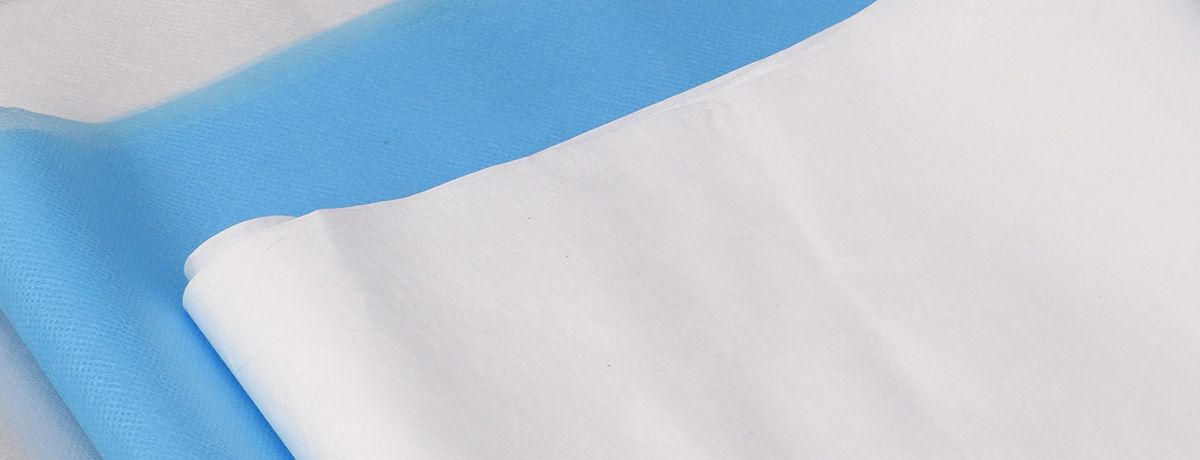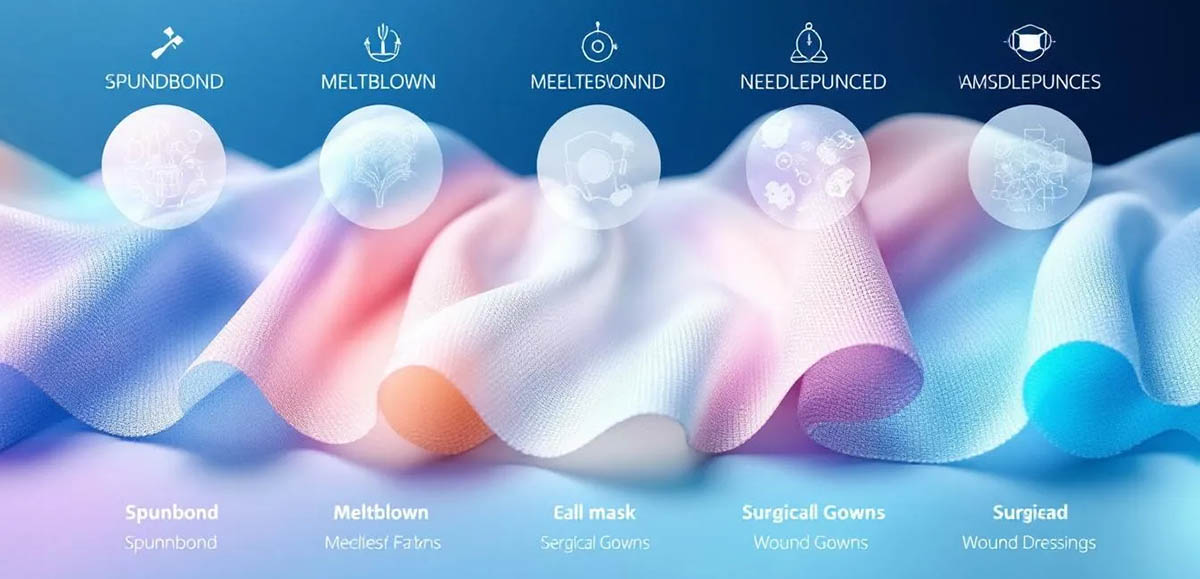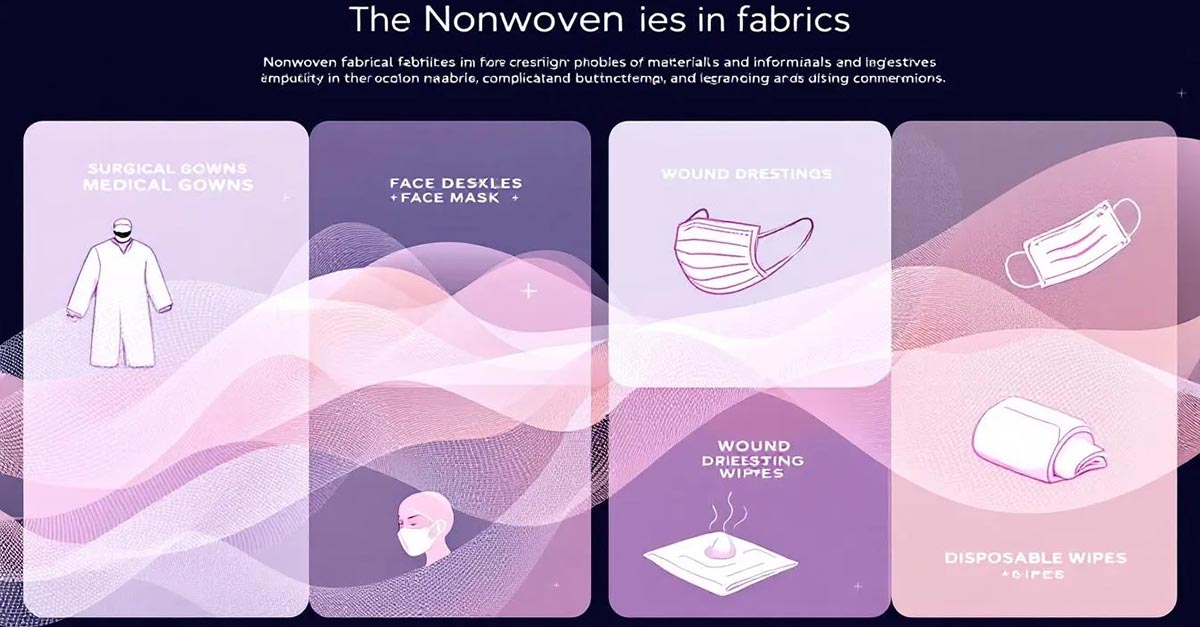Top Innovations in Nonwovens in Medical Textiles

Nonwovens in medical textiles are crucial for ensuring safety and comfort in healthcare. Used in products like gowns, masks, and wound dressings, they provide vital barrier protection and fluid resistance. This article delves into their key benefits, applications, and how they are made.
Key Takeaways
-
Nonwoven fabrics are essential in medical textiles due to their lightweight, versatile nature, and excellent barrier properties, making them ideal for applications such as surgical gowns, masks, and wound dressings.
-
Key benefits of nonwoven medical textiles include effective bacterial and viral barriers, hypoallergenic properties, comfort during use, and adaptability for various medical needs, enhancing patient safety and care.
-
Innovations in nonwoven manufacturing techniques and composite structures have advanced medical textiles, while sustainable solutions are being developed to address the environmental challenges associated with disposable medical products.
Defining Nonwoven Fabrics in Medical Textiles

Nonwoven fabrics are a marvel of modern engineering, characterized by their versatile, lightweight nature and excellent barrier properties. These fabrics are designed to meet the specific needs of medical applications, making them indispensable in healthcare settings. Unlike traditional woven fabric, nonwovens are made by bonding fibers together through mechanical, chemical, or thermal processes, resulting in a non woven fabric that is both strong and durable.
The materials used to create nonwoven fabrics for medical products are carefully selected to ensure optimal performance. Common materials include polyester, rayon, and cotton, as well as blends of these fibers. These materials are chosen for their ability to provide fluid resistance, breathability, and barrier protection, which are essential in medical environments. Additionally, the porosity of nonwoven fabrics, controlled by factors such as fiber density and orientation, plays a crucial role in their effectiveness.
Nonwoven fabrics are categorized by their intended applications and performance characteristics. For instance, medical nonwovens can be designed for use in:
-
Surgical gowns
-
Masks
-
Wound dressings
-
And more
The basic types of nonwoven fabrics, such as SS, SSS, SMS, and SMMS, refer to different structural configurations that enhance their suitability for various medical applications.
One of the most significant advantages of nonwoven fabrics is their ability to combine multiple layers to achieve desired mechanical properties. This multi-layered approach enhances the fabric’s strength and durability, making it ideal for demanding medical applications. Understanding the unique properties and construction methods of nonwoven fabrics highlights their pivotal role in advancing medical textiles.
Key Benefits of Nonwoven Medical Textiles
Nonwoven fabrics offer a plethora of benefits that make them the material of choice in the medical and healthcare industry. One of the most critical advantages is their ability to provide effective barriers against bacteria and viruses, significantly enhancing patient safety. This property is particularly crucial in preventing hospital-acquired infections, a major concern in healthcare facilities.
Composite nonwovens, engineered to include antimicrobial properties, further address the issue of infections by actively preventing the growth of harmful microorganisms. Nonwoven fabrics are hypoallergenic due to their low linting properties, making them safe for sensitive applications and reducing the risk of allergic reactions.
Comfort is another vital benefit of nonwoven medical textiles. These fabrics:
-
Are lightweight and breathable, ensuring they do not cause discomfort during prolonged use.
-
Are particularly important for disposable medical products like surgical gowns and masks, which need to be comfortable for healthcare professionals to wear for extended periods, promoting patient comfort.
-
Can be engineered for specific properties such as softness and strength, enhancing their suitability for various medical applications.
The versatility of nonwoven fabrics extends to their ability to be designed for liquid repellency or highly absorbent properties, catering to a wide range of medical needs. This adaptability makes them ideal for applications such as wound dressings and sanitary products, where bodily fluids management is critical. Furthermore, nonwoven medical textiles are cost-effective due to their efficient manufacturing processes and disposability, making them an economical choice for healthcare facilities.
Applications of Nonwoven Fabrics in Healthcare

Nonwoven fabrics have revolutionized healthcare with their diverse applications, offering solutions that enhance patient care and safety. One of the most common uses of nonwoven fabrics is in wound dressings. These materials are specifically designed to:
-
Manage fluids
-
Promote healing
-
Prevent infections making them essential in wound care. The high absorbency of nonwoven wound dressings ensures that exudates are efficiently managed, reducing the risk of wound complications.
Surgical gowns and masks are other critical applications of nonwoven fabrics in healthcare. These products provide:
-
Effective barrier protection against microorganisms, fluids, and particles, ensuring the safety of both patients and healthcare professionals.
-
Nonwoven surgical gowns are preferred for their single-use nature, which enhances sanitation and reduces the risk of cross-contamination.
-
Nonwoven masks, including N95 respirators, offer high filtration efficiency, making them indispensable during pandemics and in other high-risk environments.
The versatility of nonwoven fabrics extends to hygiene products, such as sanitary napkins and incontinence products. These products benefit from the absorbent pads properties of nonwovens, providing comfort and protection to users. Additionally, biodegradable nonwoven products, including gloves and masks, offer an eco-friendly alternative without compromising functionality.
Nonwoven fabrics also play a significant role in tissue engineering and regenerative medicine. Composite nonwovens used as scaffolds provide high porosity and surface area, facilitating better cell attachment and growth. This application is crucial in developing advanced medical treatments and improving patient outcomes. Furthermore, polypropylene nonwoven materials are preferred for hernia meshes due to their ability to integrate with tissue and minimize adhesion formation.
The healthcare industry continues to benefit from the unique qualities of nonwoven fabrics, making them a versatile and indispensable component of medical products. Their ability to meet the demanding requirements of various medical applications ensures that nonwovens remain at the forefront of healthcare innovation.
Advanced Manufacturing Techniques for Medical Nonwovens
The manufacturing techniques used to produce nonwoven fabrics are as diverse as their applications in the medical field. One of the most common methods is the spunbond process, which involves the continuous formation, spinning, and bonding of filaments to create a strong, durable fabric. This technique is widely used to produce nonwoven fabrics for surgical gowns, drapes, and other medical products.
Meltblown nonwovens, characterized by their finer diameter fibers and lower tensile strength, are produced using polymers with lower melt viscosity compared to spunbond nonwovens. This process results in fabrics with high filtration efficiency, making them ideal for medical masks and other filtration applications. The combination of spunbond and meltblown layer, known as SMS nonwoven fabric, enhances the overall performance of medical products by providing both strength and filtration efficiency.
Centrifugal spinning is another advanced technique used in the production of nonwoven fabrics, including those made from continuous filaments. This method utilizes centrifugal force to create fibers from a polymer solution or melt, resulting in nonwovens with unique properties suitable for various medical applications.
Additionally, needle punching, a mechanical process that interlocks fibers to strengthen the web structure, is commonly used to produce durable nonwoven fabrics for wound dressings and other medical products.
These advanced manufacturing techniques contribute significantly to the effectiveness and versatility of nonwoven medical textiles. Appreciating the innovation and engineering behind their production highlights the importance of these essential medical products.
Nonwoven Fabrics in Personal Protective Equipment (PPE)
Nonwoven fabrics are a cornerstone of personal protective equipment (PPE) in the medical industry, offering unparalleled protection and comfort. Their lightweight nature, breathability, and high surface area for enhanced functionalization make them ideal for PPE applications. Key properties of nonwoven fabrics used in PPE include mechanical protection, viral/bacterial barrier properties, and disposability, all of which contribute to the safety of healthcare professionals and patients alike.
Nonwoven materials are central to a wide range of surgical products, including gowns, surgical caps, face masks, and shoe covers. For instance, nonwoven surgical gowns provide excellent barrier protection and are preferred for their single-use nature, which enhances sanitation and reduces the risk of infection. Nonwoven masks, such as surgical masks and N95 respirators, incorporate multiple layers to achieve high filtration efficiency and comfort.
The structure of nonwoven masks typically involves an outer layer spunbond layer, a middle meltblown filter layer, and an inner absorbent spunbond layer, making a total of three layers. This multi-layered approach ensures that the masks provide effective filtration while remaining comfortable to wear. Meltblown fabrics, with their high filtration efficiency, are essential in producing N95 masks, which are critical for respiratory protection in medical settings. The outer layers of the masks play a crucial role in their overall effectiveness.
Innovations such as antimicrobial coatings on nonwoven filters further enhance the efficacy of PPE by preventing the spread of pathogens. The disposable nature of nonwoven PPE also ensures that contaminants are effectively eliminated, reducing the risk of cross-contamination and surgical infections.
Sustainable Solutions in Nonwoven Medical Textiles
The rise in single-use nonwoven PPE has led to significant medical waste, prompting discussions on sustainability and the need for alternative materials. Environmental concerns are driving the demand for biodegradable and recyclable nonwoven materials in the medical sector. These sustainable solutions aim to reduce the environmental impact of disposable products and disposable medical products without compromising their functionality.
Biodegradable nonwoven products, made from materials such as PLA and PBAT, offer a viable eco-friendly alternative. These products can decompose up to 95% within 90 days, significantly reducing the amount of medical waste. Additionally, the manufacturing of biodegradable nonwovens typically requires less energy compared to traditional nonwoven products, further lowering their environmental footprint.
Hydroentanglement, a process that uses high-pressure water jets to bond loose fibers together, is another sustainable manufacturing technique that enhances the absorbency and strength of nonwoven fabrics. Companies like WPT Nonwovens specialize in producing biodegradable nonwovens for medical products, contributing to a more sustainable healthcare industry.
Embracing sustainable solutions allows the medical industry to address the environmental challenges associated with nonwoven medical textiles. These innovations not only benefit the planet but also ensure that healthcare remains effective and safe for future generations.
Composite Nonwovens for Enhanced Medical Applications
Composite nonwovens represent a significant advancement in medical textiles, offering enhanced functionality through their layered structure. These nonwovens are composed of multiple layers of different fibers, each contributing specific properties to the overall composite nonwoven fabric. This multi-layered approach improves performance in areas such as filtration, fluid management, and barrier protection, making composite nonwovens ideal for various medical applications.
Thermal bonding techniques, which involve applying heat and pressure to solidify fibers together, create strong bonds without melting the fibers completely. This method enhances the mechanical properties of composite nonwovens, including high tensile strength, making them suitable for demanding medical applications such as surgical facemasks and wound care products.
Chemical bonding, which uses bonding agents to enhance adhesion and mechanical integrity, is another technique that contributes to the effectiveness of composite nonwovens. The integration of advanced bonding techniques ensures that composite nonwovens provide the necessary strength, durability, and functionality required in medical textiles.
These innovations enable the development of medical products that offer superior performance and protection for medical use, meeting the high standards of healthcare applications in the healthcare industry.
Innovations in Nonwoven Wound Dressings
Innovations in nonwoven wound dressings have transformed wound care, offering features that promote healing, reduce scarring, and provide high absorbency. Nonwoven wound dressings can be designed to offer moisture control and low skin adhesion, which are beneficial for wound healing. These properties ensure that the dressings do not stick to the wound, reducing pain and discomfort during dressing changes.
Recent developments in wound dressings include:
-
Hydrogels and foams that significantly enhance the healing process by maintaining moisture and absorbing exudate.
-
These materials create an optimal healing environment, promoting faster recovery and reducing the risk of infection.
-
Nonwoven scaffolds used in wound care that can influence the behavior of contractile cells in the wound bed, reducing scar formation. Additionally, wound dressing materials play a crucial role in these advancements.
The integration of growth factors into wound dressings is another innovative approach that promotes cellular regeneration and accelerates the healing process. Antimicrobial wound dressing, which incorporate various agents to reduce surgical site infection risks, are also becoming increasingly popular in wound care.
Stimuli-responsive hydrogels, which react to changes in environmental conditions such as pH and temperature, further enhance the functionality of nonwoven wound dressings. These innovations in nonwoven wound dressings exemplify the continuous advancements in medical textiles, offering solutions that improve patient outcomes and enhance the overall quality of care.
Challenges and Future Trends in Medical Nonwovens
While nonwoven medical textiles offer numerous benefits, the industry faces several challenges that need to be addressed to ensure continuous innovation and sustainability. One of the primary concerns is the environmental impact of single-use nonwoven products. The rise in disposable medical products has led to significant medical waste, prompting the need for more sustainable solutions.
The COVID-19 pandemic highlighted the critical role of nonwoven fabrics in personal protective equipment (PPE), leading to a surge in demand for these materials. This increased awareness of health and safety has driven innovation in the development of nonwoven medical textiles. However, the market is now experiencing an oversupply of nonwoven materials, impacting pricing and pushing manufacturers to focus on specialized medical applications.
Another challenge is the workforce shortage in the nonwoven manufacturing sector. To address this issue, nonwovens manufacturers are adapting product designs to simplify application processes, making them easier to use and more efficient. Additionally, regulatory challenges persist, requiring manufacturers to develop cutting-edge technologies to maintain competitiveness in the market.
Looking ahead, the shift from reusable to single-use nonwoven products is expected to continue due to their cost-effectiveness and hygiene benefits. Clinical trials are ongoing to evaluate the efficacy of innovative hydrogel-based treatments for chronic wounds and burns, promising new advancements in wound care. As the industry evolves, the focus will be on developing sustainable solutions and addressing the challenges to ensure the continued growth and success of nonwoven medical textiles.
Summary
Nonwoven fabrics have revolutionized the medical textile industry with their unique properties, versatility, and wide range of applications. From surgical gowns and masks to advanced wound dressings, nonwoven medical textiles offer solutions that enhance patient safety, comfort, and recovery. Their ability to provide effective barriers against bacteria and viruses, along with their hypoallergenic nature, makes them indispensable in healthcare settings.
As we look to the future, the focus will be on addressing the challenges related to sustainability, regulatory compliance, and workforce shortages. Innovations in manufacturing techniques, composite nonwovens, and smart wound care solutions will continue to drive the industry forward. By embracing sustainable practices and developing cutting-edge technologies, the nonwoven medical textile industry will remain at the forefront of healthcare innovation, ensuring better outcomes for patients and healthcare professionals alike.
Frequently Asked Questions
What are nonwoven fabrics, and why are they important in medical textiles?
Nonwoven fabrics are engineered materials created by bonding fibers, and they are vital in medical textiles for their superior barrier properties, fluid resistance, and breathability, which make them suitable for surgical gowns, masks, and wound dressings.
What are the benefits of using nonwoven medical textiles?
Nonwoven medical textiles provide effective barriers against bacteria and viruses while being hypoallergenic and cost-effective. Their ability to be tailored for specific properties such as softness, strength, and absorbency makes them ideal for disposable medical products.
How are nonwoven fabrics used in personal protective equipment (PPE)?
Nonwoven fabrics are essential in personal protective equipment (PPE) due to their lightweight, breathable characteristics and ability to provide effective barriers against viruses and bacteria. They are commonly used in items such as masks, surgical gowns, caps, and shoe covers, ensuring both protection and disposability.
What are the sustainable solutions for nonwoven medical textiles?
Sustainable solutions for nonwoven medical textiles involve utilizing biodegradable and recyclable materials like PLA and PBAT, as well as employing hydroentanglement techniques, which improve fabric properties while reducing environmental impact. This approach not only enhances performance but also contributes to ecological preservation.
What are some of the challenges and future trends in the nonwoven medical textile industry?
The nonwoven medical textile industry faces significant challenges such as sustainability concerns and regulatory compliance. However, future trends indicate a shift towards specialized medical applications and innovative, environmentally sustainable solutions.
Contact MH
MH offer nonwovens in medical textiles. Please contact us for more details or inquiries. We're here to help!


